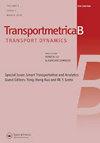Mode differentiation in partitioning of mixed bi-modal urban networks
IF 3.4
2区 工程技术
Q2 TRANSPORTATION
引用次数: 1
Abstract
ABSTRACT Empirical studies have demonstrated the existence of a well-defined Network Macroscopic Fundamental Diagram (NMFD). Well-shaped NMFD, however, may not be a universal law because urban networks often display heterogeneous congestion distributions. Therefore, different algorithms have been proposed to partition a heterogeneous network into homogeneous sub-networks. These algorithms mainly consider uni-modal networks, despite the multi-modal nature of urban traffic flows. This paper is one of the first studies dedicated to the partitioning problem of bi-modal networks. First, a three-step partitioning algorithm is developed concerning NMFD-based applications. Second, the role played by mode differentiation in bi-modal network partitioning is investigated through the lens of speed-NMFDs. The results demonstrate that the algorithm performs well. Mode differentiation should be considered in the partitioning process while is defined differently in free-flow and saturated conditions. The links' lengths, bus stop distribution, speed limit zone, and the existence of bus terminals might affect speed-NMFD properties.混合型双模城市网络划分中的模式区分
本文章由计算机程序翻译,如有差异,请以英文原文为准。
求助全文
约1分钟内获得全文
求助全文
来源期刊

Transportmetrica B-Transport Dynamics
TRANSPORTATION SCIENCE & TECHNOLOGY-
CiteScore
5.00
自引率
21.40%
发文量
53
期刊介绍:
Transportmetrica B is an international journal that aims to bring together contributions of advanced research in understanding and practical experience in handling the dynamic aspects of transport systems and behavior, and hence the sub-title is set as “Transport Dynamics”.
Transport dynamics can be considered from various scales and scopes ranging from dynamics in traffic flow, travel behavior (e.g. learning process), logistics, transport policy, to traffic control. Thus, the journal welcomes research papers that address transport dynamics from a broad perspective, ranging from theoretical studies to empirical analysis of transport systems or behavior based on actual data.
The scope of Transportmetrica B includes, but is not limited to, the following: dynamic traffic assignment, dynamic transit assignment, dynamic activity-based modeling, applications of system dynamics in transport planning, logistics planning and optimization, traffic flow analysis, dynamic programming in transport modeling and optimization, traffic control, land-use and transport dynamics, day-to-day learning process (model and behavioral studies), time-series analysis of transport data and demand, traffic emission modeling, time-dependent transport policy analysis, transportation network reliability and vulnerability, simulation of traffic system and travel behavior, longitudinal analysis of traveler behavior, etc.
 求助内容:
求助内容: 应助结果提醒方式:
应助结果提醒方式:


